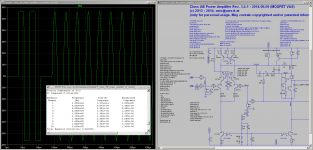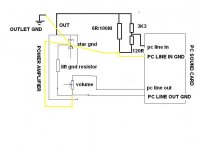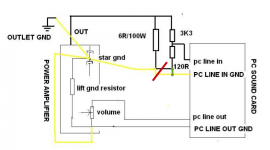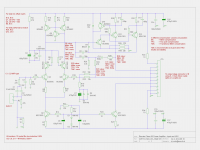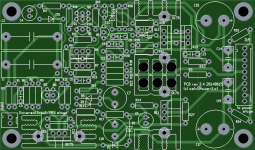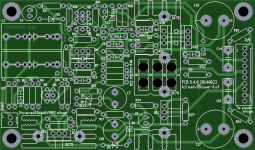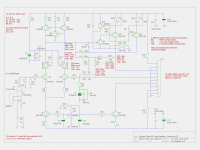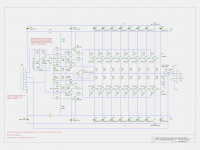... is embedded in the asc file.
Yes, I see it. Thank you.
Thanks!
DFD2 of SARA looks really excellent - but why is DFD3 so much higher? Try to repeat your measurements with linear frequency scale and an averaging of about 8 to 16 times...
Same again as loopback reference to be sure, DFD3 does not come from soundcard.
Thank you for the tips
For Asus Xonar, you can try another clean 12V power supply and the noise and distortions maybe will get down a little. Better soundcard it is again Xonar, Essence STXII, but isn't too cheap. For me your amplifier measurements are enough to know you have an excellent product built from scratch. Have a good day.
Attached are the results. NFB gain at 20 kHz drops from 60db to 42db compared to enhanced VAS. Maybe I will try this variant the next days in real life. Hopefully the mosfet spice file is not too far away from reality.
- during lab cleanup I found a couple of IRF9610 lying around from an old papa Pass project
- found an IRF9610 spice file
- simulated SA2013 v3.4 using IRF9610 for VAS
...
Attached the test results of the MOSFET VAS. It works fine and real life THD isn't so far away from simulation.
CCID IMD 0.002% @ 100W @ 8Ω
Have fun, Toni
Attachments
Last edited:
Attached the test results of the MOSFET VAS. It works fine and real life THD isn't so far away from simulation.
CCID IMD 0.002% @ 100W @ 8Ω
Have fun, Toni
0,002% in simulation and 0,1% measured is a factor of 50?
Stil very interesting measurements. Can I ask how much the amount of feedback is at 20khz?
Have you listened to the FET VAS? What do you think about vs the bjt vas?
0,002% in simulation and 0,1% measured is a factor of 50?
Stil very interesting measurements. Can I ask how much the amount of feedback is at 20khz?
Have you listened to the FET VAS? What do you think about vs the bjt vas?
- The factor is even worse. More as 100 times higher THD at full power 20kHz real life versus simulation. The sentence "THD isn't so far away from simulation." was meant as a joke!
- Feedback from simulation is about 40dB@20k
- Haven't listened to it.
- IMHO: not worth building it unless you need it for a subwoofer
Last edited:
IMD measurement using ARTA running under Linux/Wine
One step forward eliminating the need of a M$ operating system: Today I got ARTA running under openSUSE 13.1 using wine 1.7.17 (setup doesn't work under wine, but copying the installed files from windows / "Program Files (x86)/ArtaSoftware" to linux wine drive_c works)
Attached ARTA device settings under Linux using Asus Xonar STX. You can control the device settings using the console program "alsamixer". Switching output to headphone or line out, control headphone impedance ...
Awesome!
See attached pictures of some settings and a redone IMD measurement as I was now able to use the headphone outputs instead of line out.
Pictures:
One step forward eliminating the need of a M$ operating system: Today I got ARTA running under openSUSE 13.1 using wine 1.7.17 (setup doesn't work under wine, but copying the installed files from windows / "Program Files (x86)/ArtaSoftware" to linux wine drive_c works)
Attached ARTA device settings under Linux using Asus Xonar STX. You can control the device settings using the console program "alsamixer". Switching output to headphone or line out, control headphone impedance ...
Awesome!
See attached pictures of some settings and a redone IMD measurement as I was now able to use the headphone outputs instead of line out.
Pictures:
- ARTA devices settings under linux/wine
- alsamixer settings
- IMD reference of soundcard
- IMD 50W@8R
- IMD 100W@8R
- IMD 200W@8R
Attachments
-
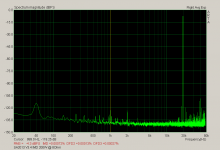 sa2013_v34_imd_200w_8r.png11.8 KB · Views: 181
sa2013_v34_imd_200w_8r.png11.8 KB · Views: 181 -
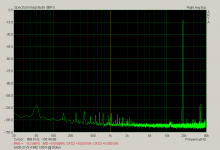 sa2013_v34_imd_100w_8r.png11.8 KB · Views: 177
sa2013_v34_imd_100w_8r.png11.8 KB · Views: 177 -
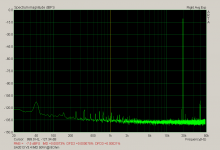 sa2013_v34_imd_50w_8r.png11.9 KB · Views: 183
sa2013_v34_imd_50w_8r.png11.9 KB · Views: 183 -
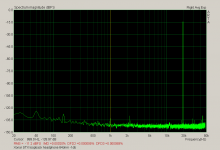 xonar_imd_loopback_headphone_64ohm.png11.6 KB · Views: 596
xonar_imd_loopback_headphone_64ohm.png11.6 KB · Views: 596 -
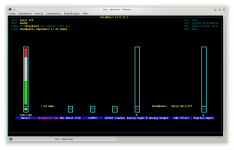 xonar_alsamixer_settings.png77.3 KB · Views: 597
xonar_alsamixer_settings.png77.3 KB · Views: 597 -
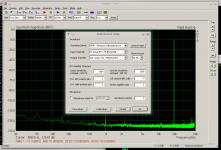 wine_linux_arta_settings.png53 KB · Views: 609
wine_linux_arta_settings.png53 KB · Views: 609
Hi astx nice work!One step forward eliminating the need of a M$ operating system: Today I got ARTA running under openSUSE 13.1 using wine 1.7.17 (setup doesn't work under wine, but copying the installed files from windows / "Program Files (x86)/ArtaSoftware" to linux wine drive_c works)
Attached ARTA device settings under Linux using Asus Xonar STX. You can control the device settings using the console program "alsamixer". Switching output to headphone or line out, control headphone impedance ...
Awesome!
See attached pictures of some settings and a redone IMD measurement as I was now able to use the headphone outputs instead of line out.
Pictures:
- ARTA devices settings under linux/wine
- alsamixer settings
- IMD reference of soundcard
- IMD 50W@8R
- IMD 100W@8R
- IMD 200W@8R
Can you share a schematic how amplifier connected with load ,attenuetor and sound card?
I have troubles with this
I used the setup as photo.
Did you try using Step (ARTA)?
Thimios.
Attachments
Last edited:
Hi astx nice work!
Can you share a schematic how amplifier connected with load ,attenuetor and sound card?
I have troubles with this
I used the setup as photo.
Did you try using Step (ARTA)?
Thimios.
Thx! Didn't use STEPS as I have a PANASONIC/LEVEAR VP-7723D audio analyzer which has a better THD resolution as the Xonar up to 100kHz.
Attached the modified setup. I have used 9k resistor and 1k poti to trim output level to sound card sweet spot. The signal from amplifier has been taken directly after output coil using a osci probe (ground clips at probe isolated to avoid ground loop).
Have fun!
BR Toni
Attachments
Thx! Didn't use STEPS as I have a PANASONIC/LEVEAR VP-7723D audio analyzer which has a better THD resolution as the Xonar up to 100kHz.
Attached the modified setup. I have used 9k resistor and 1k poti to trim output level to sound card sweet spot. The signal from amplifier has been taken directly after output coil using a osci probe (ground clips at probe isolated to avoid ground loop).
Have fun!
BR Toni
The signal from amplifier has been taken directly after output coil using a osci probe (ground clips at probe isolated to avoid ground loop).
And the load? where connected the load(in your configuration)?
Last edited:
Of course 8R load was connected from amplifier output to power/star -ground as shown in the simple schematic.And the load? where connected the load(in your configuration)?
Ok thanks i will try this modification soon.Of course 8R load was connected from amplifier output to power/star -ground as shown in the simple schematic.
Best regards.
Thimios.
Under windows you normally need something like ASIO drivers to get native access to special soundcard hardware capabilities (eg. 88.2kHz sampling using 24bit resolution). If using Windows WDM drivers every sound output is being reprocessed by libraries - e.g. an original 88.2kHz/24bit audio will be for example recalculated/normalized to a lower resolution of 48kHz/16bit.Is there any difference in the soundcard output when using Linux? There is also OSS which is an alternative to ALSA that some people say gives better quality.
Using higher level functions of OSS or ALSA does the same, but we get direct soundcard hardware access when we need it.
BTW: if OSS gives measureable better quality as ALSA maybe the resampling algorithms are better? Have you more information about it?
But for audiophile listening/measurements we don't want any type of resampling...
Some words about my Asus Xonar STX: have replaced all opamps on sockets with LM4562.
Last edited:
OSS has a "production quality" resampler that can be enabled if you build from source. However I use a plugin for my audio player that has an FFT-based resampler (rather than interpolation) that's as good you can get based on my tests, and bypass the driver resamplers.
ALSA has had problems with buggy DSP routines, reporting samplerate incorrectly, stuff like that which makes people apprehensive of the quality of the code.
ALSA has had problems with buggy DSP routines, reporting samplerate incorrectly, stuff like that which makes people apprehensive of the quality of the code.
Maybe this is history? Today ALSA is the defacto standard using current kernels and there exists an emulation layer for OSS based software....
ALSA has had problems with buggy DSP routines, reporting samplerate incorrectly, stuff like that which makes people apprehensive of the quality of the code.
What I like is that you always can check which input/output sample rates are currently used.
E.g.: during loopback test using ARTA 96kHz/32:
myhost:/proc/asound/STX # dir
insgesamt 0
-r--r--r-- 1 root root 0 15. Jun 11:26 id
-rw-r--r-- 1 root root 0 15. Jun 11:26 oss_mixer
-r--r--r-- 1 root root 0 15. Jun 11:26 oxygen
dr-xr-xr-x 3 root root 0 15. Jun 11:26 pcm0c
dr-xr-xr-x 3 root root 0 15. Jun 11:26 pcm0p
dr-xr-xr-x 3 root root 0 15. Jun 11:26 pcm1c
dr-xr-xr-x 3 root root 0 15. Jun 11:26 pcm1p
myhost:/proc/asound/STX # cat ./pcm0c/sub0/hw_params
access: RW_INTERLEAVED
format: S32_LE
subformat: STD
channels: 2
rate: 96000 (96000/1)
period_size: 960
buffer_size: 3840
myhost:/proc/asound/STX # cat ./pcm0p/sub0/hw_params
access: RW_INTERLEAVED
format: S32_LE
subformat: STD
channels: 2
rate: 96000 (96000/1)
period_size: 960
buffer_size: 3840
insgesamt 0
-r--r--r-- 1 root root 0 15. Jun 11:26 id
-rw-r--r-- 1 root root 0 15. Jun 11:26 oss_mixer
-r--r--r-- 1 root root 0 15. Jun 11:26 oxygen
dr-xr-xr-x 3 root root 0 15. Jun 11:26 pcm0c
dr-xr-xr-x 3 root root 0 15. Jun 11:26 pcm0p
dr-xr-xr-x 3 root root 0 15. Jun 11:26 pcm1c
dr-xr-xr-x 3 root root 0 15. Jun 11:26 pcm1p
myhost:/proc/asound/STX # cat ./pcm0c/sub0/hw_params
access: RW_INTERLEAVED
format: S32_LE
subformat: STD
channels: 2
rate: 96000 (96000/1)
period_size: 960
buffer_size: 3840
myhost:/proc/asound/STX # cat ./pcm0p/sub0/hw_params
access: RW_INTERLEAVED
format: S32_LE
subformat: STD
channels: 2
rate: 96000 (96000/1)
period_size: 960
buffer_size: 3840
If I may ask you about used player and plugin?...However I use a plugin for my audio player that has an FFT-based resampler (rather than interpolation) that's as good you can get based on my tests, and bypass the driver resamplers.
...
TIA, Toni
SA2013 V3.4 input stage pcb ...
... just sent to fab.
As always schematics and pcb gerber files are free to use only for non commercial DIY projects.
Have fun,
Toni
... just sent to fab.
As always schematics and pcb gerber files are free to use only for non commercial DIY projects.
Have fun,
Toni
Attachments
SA2013 V3.4 bias and output stage pcb ...
Schematics and pcb gerber files are free to use only for non commercial DIY projects.
Schematics and pcb gerber files are free to use only for non commercial DIY projects.
Attachments
- Home
- Amplifiers
- Solid State
- 2stageEF high performance class AB power amp / 200W8R / 400W4R
